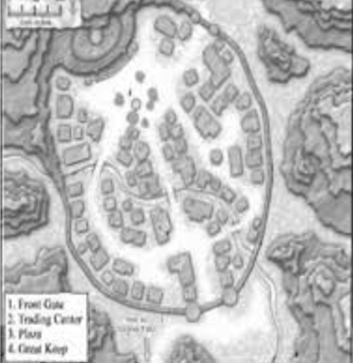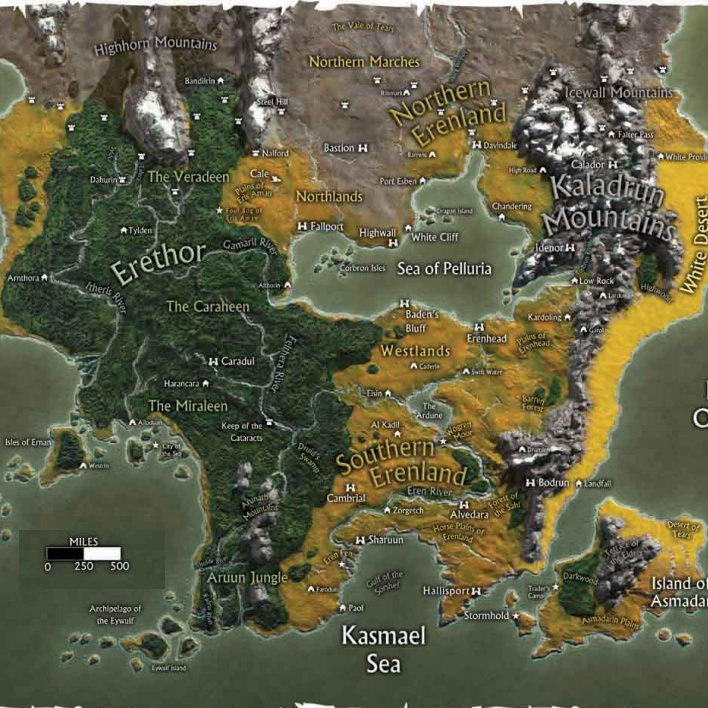Races of Aryth:
Human, Dorn
Those humans descended from the houses of the Old Kings, known commonly as the Northmen, still live in the lands north of the Sea of Pelluria. Those that remain in the environs of their ruined cities live at the will of their orc masters and survive off what subsistence they can grow, poach, or scrounge. Others huddle in subsistence communities on the vast stretches of hill country and tundra, left to lives of misery only occasionally interrupted by orc patrols and legates seeking provision and tithes. Those that choose to run as outlaws, bearing illegal weapons and raiding supplies from the dark god's chosen, must always be on the move lest they be hunted down and slaughtered.
Dornish people are big, even for humans with broad shoulders and long limbs. They have pale skin and green or blue eyes. Their hair ranges from gold to red and was once worn long and bound with metal rings, each ring commemorating a battle in which the individual had fought. Now most Dorns, even many women, shave their heads as a symbol of shame at their defeat by the forces of Izrador. Dorns once wore painted leather coats, fur boots and heavy woolen kilts and gowns whose patterns marked their house allegiances. Now they are lucky to have dirty rags in which to wrap their hungry bodies.
The Dornish people once swore fealty to the Old Kings of the Great Houses. The nobles were fiercely loyal to their people, who repaid that devotion by adhering to familial codes of honor in both social interactions and in battle. In the days of the old, death was seen as far preferable to dishonoring one's clan; every action a Dorn undertook, whether repairing his farmstead's wall or meeting a foe in battle, was to reflect proudly on his King. But with the betrayal of the Night King Jahzir, Gregor Chander, and several other Traitor Princes, most Northmen are now only loyal to their own skins and swear fealty only to their stomachs. The shades of their ancestors, which traditional Dorns honor with altars, prayers and sacrifices, would weep to see what has become of their once-great people.
In the centuries since the Sarcosans came to Eredane, the Dorns have become excellent riders, though they still prefer to fight on foot. Their weapons of choice were longspears and greatswords, though some chose to carry large battleaxes. Today, orc patrols kill armed humans on sight so the rare Dorns who go armed use whatever weapons are available.
Human, Sarcosan
The humans of southern Erenland are smaller and much leaner than the big Northmen. They have dark brown skin and black, shiny hair. Their eyes are the deepest brown and set in narrow lids that grant them hard stares when angry and bright smiles when pleased. They paint their skins with herbal salves that bleach intricate, pale designs on their faces, arms, and chests for nothing more than the haunting beauty it creates. They dress in flowing pants and loose robes that offer them both protection from the elements and the freedom they need to ride and fight.
Like the Northmen, these southlanders once swore allegiance to noble princes. With the rule of the Shadow, most of those sussars, or sworn riders, have been killed or sworn to ride as outlaws. Those that remain are traitors to their own people, and have become soulless and hollow tyrants under the control of the legates and their orc enforcers.
By the time the forces of Izrador had reached the southern cities of Erenland, the human armies had been crushed and only a few cities resisted. Cambrial and Alvedara were both razed for their refusal to surrender.
Sharuun, Hallisport and several other cities still stand, essentially as they did before the war. As a result, many southlanders still live in the cities their forefathers built. Unfortunately, the inflated false economies, brutal orc garrisons, and whimsically evil legates that plague these urban areas serve as a reminder that, while the cities may still stand, the spirit that built them has been all but crushed.
Sarcosan riders favor versatility and finesse over brute strength. They wield Sarcosan lances and composite longbows when on horseback. On foot, they often fight with a wickedly curved scimitar in one hand and an inward-curving short sword, called a cedeku, in the other.
Human, Erenlander
For more than 2000 years, the Northmen descendants of the Dorns and the colonial Sarcosans have lived together as two cultures unified by military, commercial, and royal alliance under the single banner of the nation of Erenland. In that time, they have also become kin through friendship and family. From the southern coast of the Pelluria to the shores of the Ardune, the peoples of both races have interbred and intermarried for so long that a new race of true Erenlanders has been born.
These people are a mix of their forebears. Not as large and pale skinned as their Dorn parents nor as slight or dark as their Sarcosan ancestors, their colorations and builds vary wildly. They are a transitional people between both Erenland's northern and southern regions as well as its past and future. Erenlanders are the true children of their kingdom, a people born of two ancient traditions but owing loyalty instead to one young nation. Though different settlements and even different families, hold more strongly to some Sarcosan and Dornish traditions, mos Erenlanders sense they are truly a unique people, something other than simply the combination of their ancestries.
Though the lack of cultural restriction means Erenlanders have greater social freedom, that freedom is not without greater social cost. Whereas respect for the past and hatred of the Shadow bind the Dornish houses and Sarcosan liegemen to their people, the Erenlanders have no such guiding lights or sense of unity. Indeed, it may have been their diluted loyalties that made many Erenlander communities fertile soil for Izrador's dark seeds in the Second and Third Ages. It is yet to be seen whether the Erenlanders of the Last Age will devolve into a directionless, broken people or will rise above the suspicions and betrayal of their time and unite the two bloodlines, north and south, Dorn and Sarcosan, that created them.
Dwarves
The dwarves are an ancient people and have a culture as rich as any in Eredane. Dwarven society is structured along familial lines, and like the Dorns, clan loyalty and honor lie at the center of their lives. Historical records indicate that in the First Age there were more than 600 dwarven clanholds spread throughout the Kaladrun Mountains. Now there are fewer than 200 and this number continues to fall as the Shadow advances.
The clan is the basic dwarven social and political unit. The smallest clans may contain as few as 100 individuals and the largest many thousands. Alliances between the clans are fluid, complicated affairs, most typically formed by intermarriage or common enemies. In bygone days, skirmishes between the various clans were common, but in the past centuries of war, such hot-bloodedness has instead been spent against the forces of Izrador. For matters of governance that affect all dwarves, great clanmoots were once called where representatives of each clan would meet in raucous assemblies to determine collective courses of action. The cantankerous and aggressive nature of these meetings is a reflection of dwarven clan relations at large.
In addition to the clan structure of dwarven society, there is another important social distinction within the dwarven culture. Most dwarves, about four out of every five clans live underground in their warren-like holdfasts that are carved out of the hard flesh of the mountains. The remaining clans are called the Kurgun, the surface dwellers. The Kurgun still live in the old dwarven surface cities of the southern Kaladruns that predate the First Age and the digging of the holdfasts.
Dwarves are a stout race, with short thick bones and heavy muscles. Their heads and chins - and most of the rest of their bodies, for that matter - are covered in thick hair in a variety of pale colours. These colours typically indicate an individual's clan heritage, as do the jewelled bangles they wear in their heavy braids.
Most dwarves live in underground cities that are warrens of chambers, rooms and great halls, all constantly being expanded by mining. The original proximity of the clans to one another, combined with their constant expansion throughout the millennia, have turned much of the central Kaladrun Mountains into a bewildering maze of tunnels and passages. The range contains countless pathways and chambers, both large and small, new and old, occupied and forgotten.
Since the fall of Erenland, the clanholds have severed almost all contact with the world beyond their mountains, and all their craft has now been turned to their race's continuing survival.
Caransil (Wood Elves)
The elves of central Erethor, the Caransil, or wood elves, are the most widespread and familiar of the woodland fey. They range from the southern Highhorns, eastward to the Plains of Eris Aman and the Westlands, and south to the Aruun Jungle. Their skin is the beautiful brown of ino treewood, and their hair tends to be shiny and black. Their eyes are large and dark and they are the tallest of the elves. They wear a variety of clothes, from the dark and mottled camouflage leathers of a scout's kit to the sunset brilliance of a courtier's elaborate silks.
These elves live in enormous maudrial, or homewood, trees that have been coaxed to grow in elegant but useful domestic shapes by age-old spells. The Caransil eat mostly fruits, vegetables, nuts and seeds. They supplement their diets with rabbits and grouse raised in family hutches and with river fish from the Gamaril and Felthera.
The wood elves are traditionally the artists, philosophers, and craftsmen of Erethor. They are also the lineage from which have come the greatest sorcerers and battle mages of recent times. Their warriors carry longbows and longswords.
Danisil (Jungle Elves)
These elves of the southern reaches of Erethor, where temperate forest gives way to tropical jungle, are small, slight and ebony skinned. Historians speculate that they may be the elven line from which the halflings were born. The uninitiated consider the Danisil "feral elves", but their culture is as sophisticated as that of their cousins. Many of Erethor's most powerful druids are of the Danisil lineage.
Their hair is dark and course and typically worn in short dreadlocks. Their eyes are black and so narrow that the whites barely show. They dress in loose shorts and brightly painted vests, but when hunting, they wear only layers of river mud to hide them from both sight and scent.
The Danisil live in boa-bil groves along the many small rivers of the Aruun Jungle. Their druids enchant vines to form large slings that suspend their tiny huts high in the jungle canopy. They live off the fruits of the forest but are also cunning hunters.
Erunsil (Snow Elves)
The elves of northern Erethor, called the Erunsil or the snow elves, are the stoutest elven stock. They dominate the forest from its northernmost reaches to the southern end of the Highborn Mountains. They are fair skinned with long braided hair the color of snow. Their eyes are narrow, shaped like sweetroot seeds, and are as pale as their skin. They wear heavy clothes and thick furs when travelling or at rest, but prefer light leathers when fighting or scouting. In those circumstances they rely more on their natural fortitude than on clothing to resist the cold.
The Erunsil live in giant shelterwood trees surrounded by groves of massive, evergreen winter oak. Their homes are magically grown hollows in the massive trees, insulated by creeper vine and heated by hearthstones. They are hunters and live off the natural bounty of the forest.
These northern elves have fought the orcs of the mountains for thousands of years and are experts at hunting this prey. They are fierce warriors and have been keys to the defense of Erethor since the Shadow first menaced the elves. They carry powerful icewood bows and vicious paired fighting knives and use both to good effect.
Miransil (Sea Elves)
The Miransil are the sea elves that dwell along the southwestern coast of Eredane, where the great forest of Erethor meets the sea. These unwarlike, thoughtful people are from the same ancestral stock of the Caransil but long ago became as bound to the spirits of the sea as their cousins are to those of the forest. The sea elves are a darker skinned people than their inland brothers, well tanned by the coastal sun. Their dark hair is worn short and bushy, and they wear loose-fitting short pants or saris.
The Miransil live over the water in the intertwining branches of giant mangrove trees whose sturdy roots protect their small harbors from ocean storms. The Miransil live off the bounty of the sea and are expert swimmers, sailors and builders of small fishing boats and coastal traders. The sea elves are few, having sent an entire generation westward in search of hope and help, but have nonetheless sent their share of soldiers east to fight Izrador's invaders.
Halflings
Halflings are a race of tiny folk that some believe descended from the Danisil lineage of southern elvenkind. They call themselves the Dunni or "the people" in their own tongue. They are almost as dark skinned as the Danisil, with the same coarse hair worn in small, intricate braids that mark their tribal membership. Their eyes range from common black to dark brown and green.
Where still free-living, the nomadic tribes dwell on the open plains in large hide tents they share with their extended families. The farming families have almost been wiped out by the advance of the Shadow, but a few groups still remain along the southwestern margins of Erethor. They dwell in cozy sod villages kept alive through their exceptional horticultural skills and the watchful presence of their wogren companions.
The halfling weapon of choice is the spear, with which they protect their flocks, hunt wild boar and skewer the occasional orc.
Gnomes
The gnomes are a clever and resourceful race. Though it is well known that they share ancient kin with the dwarves, they do not like to claim responsibility for the lineage. Gnomes are barely taller than the halflings, with only a slightly stouter build. They are bronze skinned but pale eyed, with jet black hair that they keep short as they are constantly in and out of the water.
Gnomish culture and history are characterized by their adaptable nature. Their nimble outlook on life allowed them to first move from mountain life to that of the coastal hills of the Ebon Sea, and from there to become adroit seafarers and river runners. Through all these years and new trading partners, the gnomes always knew that their conquerors longed only for land and goods. With the coming of Izrador this is not the case. They cannot fool themselves into believing that the dark god and the orcs will be content to let the survivors of the war live their lives in peace; whatever the eventual goals of the Shadow, the gnomes know that Eredane cannot survive. But the river fey's strength was not in war. So, as always, they bowed before their new masters and offered to serve. Or so it seemed.
Though the race has been subjugated along with the halflings, gnomes continue to enjoy a sort of freedom. Even the forces of the Shadow need to transport cargo and soldiers, and the river barges of the gnomes suit this purpose well. Most other races see the cost of this semi-freedom as the worst kind of enemy collaboration. What few realise is that the gnomes fight the dark god in their own way: as consummate spies and smugglers. It is their secret trade that keeps weapons, magic and information flowing amongst the free races of Eredane.
Dwarrow
The dwarrow are the offspring of gnomes and dwarves. Long ago, such pairings were common, but since the dwarves have become so withdrawn, dwarrow are increasingly rare. Dwarrow appear as stout, uncommonly strong gnomes but tend to lack their even temper and inherent personal grace. As a rule, dwarrow do not have the fortitude to survive life in the mountains. If a dwarrow is unlucky enough to be born there, he is typically sent to the rivers to live with his gnome parents family. Dwarrow are welcomed by rafters for their strong backs and stronger loyalties.
Dworgs
Dworgs are perhaps the most unfortunate race in the history of Eredane. These bastard children are the misbegotten fruit of orc raids against the dwarves and are very rare. Those that are not murdered at birth suffer a lifetime of abuse as outcasts from their own kind. Most are killed in fights with their clansmen by the time they reach adulthood. Those that survive are usually banished from the clan and forced to make their way alone.
Many of these unfortunates find their way to the Durgis clan of the Kurgun. This alienated, half-wild clan of surface dwarves has a long reputation of accepting any dwarven outcasts from other clans. The kinship dworgs find among the Durgis fills them them with a rabid dedication to their adopted clan that few full-blooded dwarves can honestly claim.
Dworgs combine the strength of their orc fathers and the fortitude of their dwarf mothers and the result is the most physically imposing race in all the lands. Dworgs have the build and proportions of their dwarven kin but are almost as tall as humans. If any race hates orcs more than the full-blooded dwarves, it is the dworgs. They blame their orc fathers for their lives as outcasts and seem to take a measure of revenge with every orc they kill.



